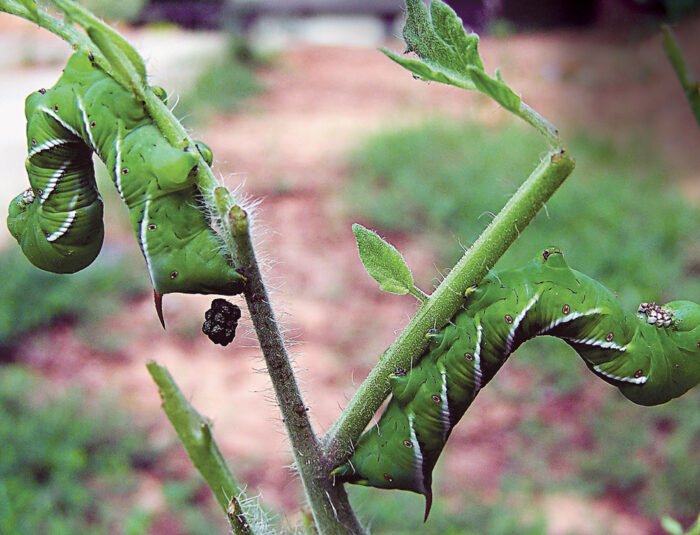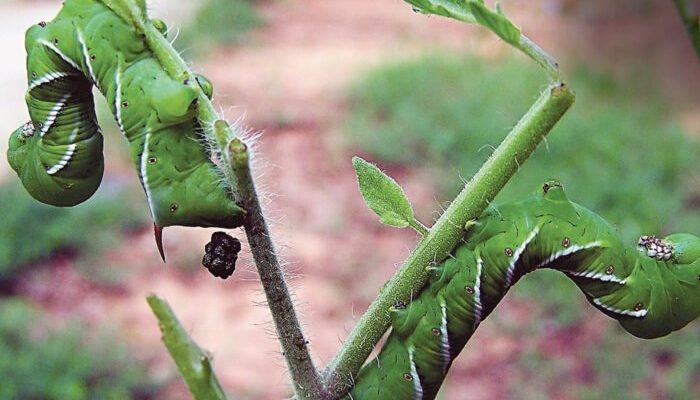
Hornworms, particularly the tomato hornworm, are known for their voracious appetites, often leaving a trail of destruction in their wake. On the other hand, general caterpillars can vary widely, with damage depending on the species. Let’s dive into the world of these pests and discover how to spot hornworm damage versus general caterpillar damage.
What Are Hornworms?
Hornworms are the larval stage of certain moths, primarily the Five-spotted Hawk Moth. These little monsters can grow quite large—up to four inches long! They sport distinctive features like a horn-like protrusion on their rear end, which is why they get their name. While they might look a bit intimidating, they’re just hungry larvae looking for something green to munch on.
In gardens, hornworms typically target plants from the nightshade family, such as tomatoes, peppers, and eggplants. Their green color helps them blend in with the foliage, making them tricky to spot. Once you realize they’re there, you might find your plants are already suffering from their relentless chewing.
Identifying Hornworm Damage
So, how can you tell if hornworms are the culprits behind your plant woes? Hornworm damage is usually characterized by a few identifiable signs:
- Large, irregular holes: Hornworms tend to eat large chunks of leaves, rather than making small bites.
- Frass (caterpillar poop): You might find dark-green or brown pellets on or near affected plants, which is a telltale sign of hornworm presence.
- Defoliated stems: If you notice entire branches stripped of leaves, hornworms are likely at work.
Hornworm damage can escalate quickly, so it’s essential to act fast. Keeping a vigilant eye on your plants can save your crop from significant loss.
What Are General Caterpillars?
General caterpillars refer to the larvae of various moths and butterflies that might not have the same notoriety as hornworms. These can range in size, color, and feeding habits. Some common types include the cabbage worm, cutworm, and the larva of the painted lady butterfly.
Unlike hornworms, general caterpillars might not be as destructive to certain plants. However, some, like the cabbage worm, can cause severe damage to cruciferous crops such as cabbage, kale, and broccoli. Understanding the different types of caterpillars can help you target your gardening defenses effectively.
Identifying General Caterpillar Damage
When it comes to identifying general caterpillar damage, the signs can vary widely depending on the species. However, there are common indicators to watch for:
- Small bites and holes: Unlike hornworms, many caterpillars take smaller bites, which can create a “lacey” appearance on leaves.
- Silk webs: Some caterpillars spin webs as they feed, which can be a clue to their presence.
- Chomping on different plants: General caterpillar damage can occur on a variety of plant types, so be vigilant across your garden.
With general caterpillar damage, it’s essential to identify the specific type of caterpillar causing the issue. This not only helps in determining the best course of action but can also inform your long-term pest management strategies.
How to Deal with Hornworms
If you suspect hornworms are wreaking havoc in your garden, don’t panic! There are several effective methods to manage these pests:
1. Inspection: Regularly check your plants for hornworms. The sooner you catch them, the less damage they can do.
2. Hand-picking: If you find hornworms, remove them by hand. They can be placed in a bucket of soapy water to kill them.
3. Natural Predators: Attract birds and beneficial insects to your garden. They can help keep hornworm populations under control.
4. Insecticides: As a last resort, use insecticides specifically designed for caterpillars. Always follow the instructions carefully to avoid harming beneficial insects.
By staying proactive, you can effectively manage hornworm damage before it spirals out of control.
How to Handle General Caterpillar Issues
Dealing with general caterpillar damage can also be approached in several ways:
1. Regular Monitoring: Keep an eye on your plants to catch any infestations early. The sooner you notice a problem, the easier it is to fix.
2. Physical Barriers: Consider using row covers to protect young plants from caterpillar infestations.
3. Trap Crops: Plant a crop that caterpillars prefer away from your main garden. This can trick them into feasting on those instead.
4. Organic Solutions: Introducing beneficial insects, such as ladybugs, can also help control caterpillar populations naturally.
By using these tactics, you can manage caterpillar damage in a sustainable way, keeping your garden healthy and thriving.
Comparing Damage: Hornworms vs. General Caterpillars
Understanding the differences in damage caused by hornworms and general caterpillars can help you make informed decisions about pest control. Here’s a quick comparison:
| Damage Type | Hornworms | General Caterpillars |
| Size of Damage | Large holes and defoliated branches | Small bites and lacey appearance |
| Identification | Green with horn-like protrusions | Diverse colors and sizes; varies by species |
| Management | Hand-picking, insecticides, attract predators | Monitoring, barriers, organic solutions |
By recognizing these differences, you can tailor your pest control approaches effectively, leading to a healthier garden.
Why It Matters
You might be wondering why distinguishing between hornworm and general caterpillar damage is critical. Well, understanding their differences helps you not only in immediate pest management but also in long-term garden health. After all, nobody wants to waste time battling the wrong enemy!
When you can accurately identify and address these threats, you’re setting yourself up for gardening success. A healthy garden means healthy plants, which leads to a bountiful harvest. Plus, knowing how to deal with these pests responsibly can also help you nurture your garden ecosystem.
In the end, a little knowledge goes a long way. Whether you’re dealing with hornworms or general caterpillars, being informed is your best weapon against garden damage. Happy gardening!

